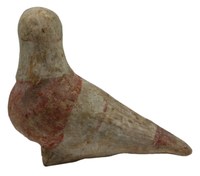Siren
|
|
Siren, Inv.T I-3 Front and back from the mould. Small kilning hole at the bottom. Hard, light brown (10 YR 7/2-3) clay with fine inclusions. White engobe. Richly painted: front part of the bird's body light red, neck decoration brick red; around the tail a broad and a narrow stripe in darker red, another runs around the bird's back. Dark red also for a band between the two curl registers above the forehead, running diagonally across the sides and around the back of the head. Lips wine red. Traces of black paint on the falling hair, especially on the sides. Short blackish lines on the base to indicate the claws. Provenance: Acquired by Bruno Sauer, from the Margaritis Collection. State of preservation: Intact. Dimensions: W: 10,7 cm; H: 8,9 cm; D: 4,4cm. References: Chr. Habrich (Hrsg.), Frankenstein. Symbolgestalt biotechnischer Grenzüberschreitung, Katalog des Medizinhistorischen Museums Ingolstadt 29, 2006, 133. 171 fig. 22; D. Graen – M. Recke, Herakles & Co. Götter und Helden im antiken Griechenland (Gießen 2010) 188 fig. 109. |
Description: The roundish female head faces the viewer and is turned 90 degrees against the bird's stocky body. In the area of the wings and the tail, flat transverse grooves indicate the plumage.
Two rows of curls frame the forehead in a flat curve, otherwise the hair falls in a compact mass on the shoulders and back.
The face is broadest at the level of the eyes and tapers continuously to the round, prominent chin. The forehead and nose form a straight continuous line. The large wide-set eyes are shallowly arched. The wide closed mouth is slightly sunken into the incarnate and shows the archaic smile. The ears have disc-shaped jewellery, and there is a pearl necklace around the neck.
Commentary: The bird creature with the female head belongs to the group of sirens[1], which were consecrated in the form of terracotta statuettes in sanctuaries and used in funerary worship[2]. The closest parallels to T I-3 come on the one hand from the necropolis of Kamiros on Rhodes[3], on the other hand from Boeotia[4]. Iconographically, they probably follow Ionian models, namely bird statuettes and figural vessels in the shape of sirens[5].
The light tone of the Giessen specimen is more indicative of Boeotian manufacture; the pronounced chin area also contrasts with the straight forehead-nose region, so that it is not possible to speak of an Ionic profile.
Stylistically, the archaic smile, the curvature of the eyeballs and the wide distance between the eyes, as well as the 90-degree rotation of the head in relation to the body axis - in Early Classical times Sirens rotate their heads only 45 degrees[6] - point to a creation of T I-3 at the end of the 6th century BC. The dating of a parallel from Kamiros fits in with this due to its find context[7].
Determination: 510/500 BC; Rhodian type, from Boeotia (?)
 |
 |
 |
|
|---|
[1] E. Buschor, Die Musen des Jenseits (München 1944); E. Hofstetter, Sirenen im archaischen und klassischen Griechenland (Würzburg 1990) 33-35.
[2] Hofstetter ibid. 24-32.
[3] Clara Rhodos IV, 1929/30, 286. 289 figs. 319. 320.
[4] S. Mollard-Besques, Cat. raisonné des figurines et reliefs I (Paris 1954) 23 no. B 136 pl. 17; B. Schmaltz, Terrakotten aus dem Kabirenheiligtum bei Theben (Berlin 1974) 136 182 no. 368 pl. 29. N. Breitenstein, Cat. of Terracottas (Copenhagen 1941) 19 nos. 165. 166 pl. 18; U. Gehrig, Antiken aus Berliner Privatbesitz 1975, no. 149; F. W. Hamdorf, Die figürlichen Terrakotten der Staatlichen Antikensammlungen (München 2014) 80 no. C 157; I. Jucker, Aus der Antikensammlung des Bernischen Historischen Museums (Bern 1970) 77 f. 120 pl. 51.
[5] Chr. Blinkenberg, Lindos (Berlin 1931) 583-585 nos. 2414. 2418. 2420. 2423. 2425 f. pl. 113; J. Ducat, Les vases plastquerhodiens (Paris 1966) 54 f. pls. 8, 3. 4; U. Liepmann, Griechische Terrakotten, Bronzen, Skulpturen (Hannover 1975) 39 f. fig. T 9; E. Simon, The Kurashiki Ninagawa Museum (Mainz 1982) 201 fig. 135; U. Sinn, Antike Terrakotten (Kassel 1977) 26 no. 17 pl. 6.
[6] Schmaltz ibid. 136.
[7] Clara Rhodos ibid. 289 fig. 319.


